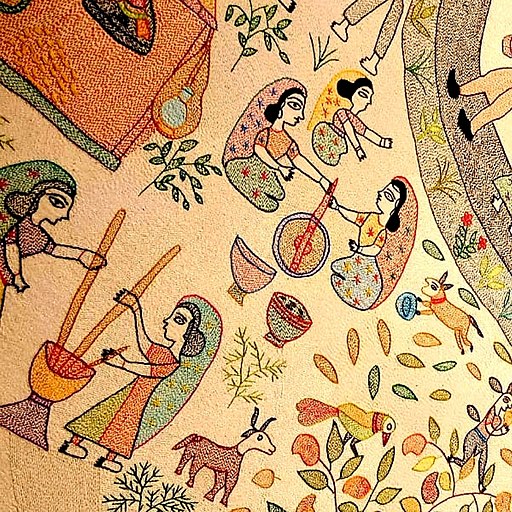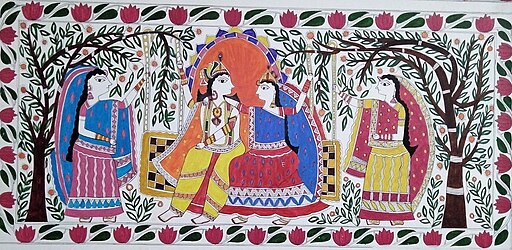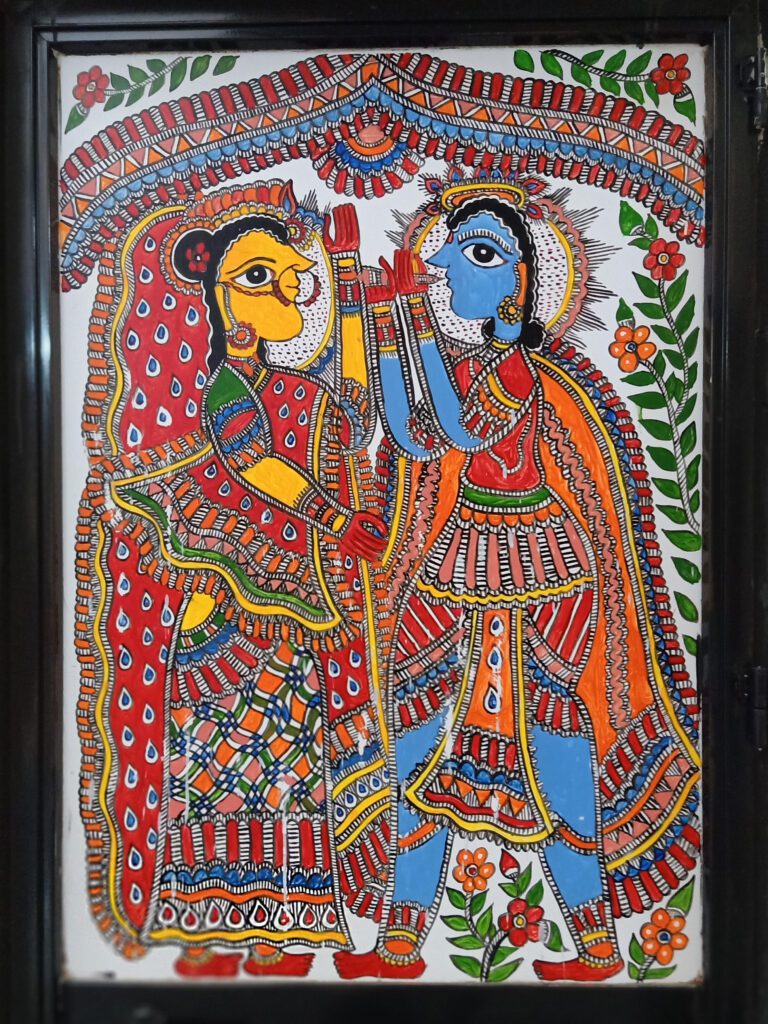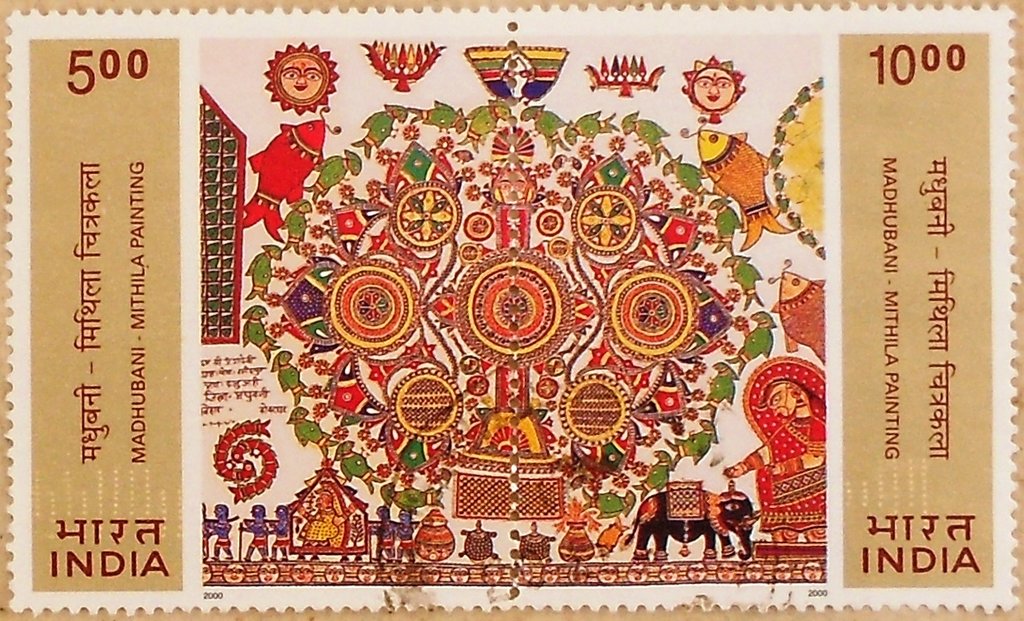Discover the essence of Madhubani painting, a traditional art from Bihar, India. Learn what is special about Madhubani painting, its historical roots, unique techniques, and its enduring influence in the global art community. Explore the cultural and symbolic significance of this captivating art form.
Introduction to Madhubani Painting
Madhubani painting, a fascinating art form originating from the Mithila region of Bihar, India, is much more than just a style of painting; it is a cultural artifact that carries the historical richness and spiritual narratives of an entire community. Known for its vibrant colors, intricate patterns, and thematic variety, Madhubani art offers a window into the age-old traditions and mythological lore of the area.
The name “Madhubani” itself is deeply rooted in local folklore and geography. “Madhu” translates to honey, and “Bani” means forest, indicating the “forest of honey” that the region was reputed to be. This painting style emerged predominantly in the villages around the Madhubani district of Bihar, hence deriving its name from its geographical cradle.
Culturally, Madhubani paintings have held significant roles beyond mere aesthetic appeal. Traditionally, this art was predominantly practiced by women on the walls and floors of their homes during festivals, religious events, and other pivotal life ceremonies. The paintings were thought to bring good luck, and as a result, have been deeply integrated into local practices and beliefs.
Madhubani art not only portrays the social and cultural fabric of its origin but also serves as a form of documentation and preservation of the collective memory of the people. Over time, this art form has transcended its original confines, finding its place in the global art market, thus contributing to the cultural dialogue between the traditional and the modern world.
The Rich History of Madhubani Art
Madhubani art’s story begins in the Mithila region of Bihar, a place steeped in ancient history and folklore. Historically, the Mithila region has been a melting pot of cultural and philosophical thoughts, which is vividly reflected in the complex themes and patterns of Madhubani paintings. This form of art is said to date back to the times of Ramayana when King Janaka of Mithila commissioned artists to create paintings at the time of his daughter Sita’s marriage to Lord Ram.
As a local tradition, Madhubani painting was originally practiced by the women of the region. It was largely a domestic ritual, passed down through generations from mother to daughter, and largely remained within the confines of communities and familial structures. The paintings often covered the walls and floors of homes, a practice that helped cement the art form’s role in both daily life and broader cultural practices. These artworks were not just decorations; they served to both beautify the living spaces and invoke divine blessings during special occasions like weddings and harvests.

The global recognition of Madhubani art owes much to a series of unforeseen events. In 1934, after a major earthquake in Bihar, the British colonial officer in Madhubani district, William G. Archer, noticed the murals in the damaged homes while inspecting the area. Fascinated by the beauty and intricacy of the designs, Archer was one of the first to document these artworks, bringing them to public attention.
Further patronage came in the 1960s and 1970s when the All India Handicrafts Board promoted Madhubani paintings under the guidance of Pupul Jayakar, the cultural adviser to Prime Minister Indira Gandhi. Efforts to commodify the art form for a market economy introduced it on national and international platforms, effectively transforming it from an esoteric cultural practice into a significant art form. This period also saw the shift of medium from mud walls to paper, cloth, and canvas, making the art more accessible and marketable.
Madhubani art has thrived through the ages not only because of its aesthetic appeal but also due to its adaptability and the resilience of its artists. Women artists of the Mithila region, such as Ganga Devi, Bharti Dayal, and Sita Devi, have become celebrated figures, showcasing their work in international art scenes and earning accolades globally. Their success has inspired many others, securing a valuable legacy for Madhubani painting and ensuring its survival and continuity as both a cultural heritage and a modern artistic expression.
Distinctive Features of Madhubani Painting
Madhubani painting, with its intricate patterns and vibrant colors, is distinguished by several unique artistic techniques and themes. This section explores the defining characteristics of this traditional Indian art form, from the techniques used to create these visual narratives to the evolution of its color palette and tools.
Artistic Techniques
The technique of Madhubani painting is characterized by its fine line drawings filled in by bright, contrasting colors. Artists use a variety of tools, originally sticks, twigs, and brushes made from cotton wrapped around bamboo sticks. The precision in the brush strokes and the tight composition are crucial, as the traditional rules of this art form allow little space for the background, urging the artist to meticulously plan and execute the patterns that fill the entire canvas.
The outlines of the designs are first sketched with rice paste, after which they are filled in with natural dyes. One of the signature techniques of Madhubani art is the use of double lines with a slight gap left between them, which is then filled with tiny cross or straight lines. This method adds a sense of movement and vibrancy to the static images.
Common Themes and Motifs
Madhubani paintings are rich in symbolism and feature motifs that are deeply rooted in the local culture and mythology of the Mithila region. Common themes include Hindu deities such as Krishna, Rama, Lakshmi, Shiva, Durga, and Saraswati. The art often captures elaborate scenes from mythology and epics, such as the Ramayana or the Mahabharata, along with celestial objects like the sun and the moon, and religious plants like tulsi (holy basil), banana leaves, and the lotus.

Animal and bird motifs are also prevalent, each symbolizing different qualities; for example, the fish symbolizes fertility, the peacock is associated with romantic love and the turtle represents the link between the earth and the heavens. The natural world is represented with an intense closeness to spirituality and divinity.
Colors and Tools: Traditional vs. Modern Adaptations
Traditionally, the palette used in Madhubani painting was strictly natural. Colors were derived from sources like turmeric (yellow), pollen (bright yellow), rice powder (white), cow dung (brown), and indigo (blue). Red was obtained from the Kusum flower sap, while black was made by mixing soot with cow dung. Over the years, with the commercialization and global exposure of Madhubani art, synthetic colors have become common, allowing for greater vibrancy and durability but sometimes at the cost of the organic essence of the paintings.
Modern adaptations have also seen changes in the mediums used. While traditionally Madhubani painting was done on freshly plastered mud walls and floors of huts, today it is also done on cloth, handmade paper, and canvas, which has helped the art form reach a wider audience. This transition from wall art to portable forms has played a crucial role in its commercial success, making it more accessible to art lovers around the world.
Through these distinctive features, Madhubani painting not only preserves a rich artistic tradition but also continues to evolve, adapting to contemporary tastes while staying rooted in its cultural heritage.
Cultural and Symbolic Significance of Madhubani Painting
Madhubani painting is deeply interwoven with the cultural fabric and spiritual life of the Mithila region. This art form serves not only as aesthetic expression but also as a vital part of the social rituals and spiritual ceremonies of its people. Here, we explore the symbolism embedded in these paintings, their role in local rituals, and the stories they tell.
Symbolism in Madhubani Paintings
Every element in Madhubani art is rich in symbolism and meaning. The motifs used are not just decorative but are chosen for their ethereal significance. For instance, the lotus flower, commonly seen in these paintings, symbolizes divine creation and purity, reflecting the core Hindu and Buddhist ethos. Similarly, the depiction of fish symbolizes fertility and prosperity. The frequent portrayal of peacocks denotes immortality and the eyes in the feathers are considered to ward off evil.
Bamboo forests are often depicted as a symbol of resilience and adaptability, echoing the characteristics of the local people who live in harmony with nature. The border designs that frame Madhubani paintings are not merely decorative; they are believed to confine the auspicious energies within the space of the artwork.
Role in Rituals and Ceremonies
In the Mithila culture, Madhubani paintings have traditionally been associated with significant life events and rituals. They are most famously painted during weddings, where the art is believed to bring good fortune, peace, prosperity, and love to the bride and groom. This practice involves the painting of auspicious symbols such as the wedding mandap, holy basil plant, and scenes from the marriage of Sita and Ram, invoking divine blessings and linking the new couple to the sacred legends of the past.

These paintings are also created during other major festivals such as Durga Puja, Kali Puja, and Diwali. Each festival might see the creation of specific icons and symbols that resonate with the themes of the occasion, serving as a visual prayer to invoke the gods and goddesses honored during these events.
Stories and Legends Depicted
Madhubani paintings are vivid narrations of mythological and folk stories. The art often depicts scenes from Hindu epics like the Ramayana and the Mahabharata. For example, a common scene might illustrate the exile of Rama, Sita’s abduction by Ravana, and the eventual defeat of Ravana and Rama’s return to Ayodhya. These stories are not merely told; they are imbued with moral and ethical lessons that reflect the virtues the community upholds.
Another popular theme is the life of Krishna, depicted in his various roles as a divine hero, a mischievous child, or a lover playing the flute. The depictions of Krishna and Radha playing together in the groves of Vrindavan are particularly beloved, symbolizing the union of the human soul with the divine.
Through Madhubani painting, the people of Mithila have found a powerful medium to express their deepest convictions and cultural stories. These artworks do more than decorate; they serve as carriers of tradition, linking past and present, and helping to preserve a rich heritage for future generations.
Modern-Day Madhubani and Its Global Influence
Madhubani painting has transitioned from a regional folk art confined to the walls of rural homes in Bihar to a globally recognized form of artistic expression. This section explores how Madhubani has adapted to the contemporary art world, its influence on modern artists and popular culture, and the concerted efforts to preserve and promote this vibrant art form on a worldwide scale.
Madhubani in the Contemporary Art World
Today, Madhubani paintings are celebrated not just in India but across the globe, featuring in art galleries, museums, and cultural exhibitions worldwide. The transition to using canvas, fabric, and handmade paper as mediums has played a pivotal role in its popularization beyond the Indian subcontinent. These adaptations have allowed Madhubani art to be more commercially viable and accessible, attracting the attention of art collectors and enthusiasts who appreciate its uniqueness and cultural richness.
Artists like Bharti Dayal have been pivotal in taking Madhubani to the international stage, showcasing the art form in countries like the USA, Canada, and many European nations. Their work has been instrumental in demonstrating that Madhubani painting can hold its own in the global art market.
Impact on Modern Artists and Popular Culture
Madhubani has had a profound impact on modern artists around the world, inspiring them to incorporate traditional motifs and techniques into contemporary art forms. Its influence extends beyond the canvas; it is seen in fashion, with designers incorporating Madhubani motifs into clothing lines, home décor, and even accessories. This blend of traditional and modern aesthetic appeals to a global audience that values both heritage and innovation.
Furthermore, Madhubani art has found its way into popular culture through various means. For instance, public art projects in cities like Madhubani railway station in Bihar have transformed mundane spaces into vibrant cultural exhibits, promoting public engagement with the art form. The visual appeal and accessibility of Madhubani have made it a favored style for public murals and installations, contributing to urban beautification projects across India.
Global Preservation and Promotion Efforts
Recognizing the cultural and artistic value of Madhubani paintings, several organizations and governments have initiated efforts to preserve and promote this art form. UNESCO has acknowledged Madhubani as an intangible cultural heritage, which has significantly boosted its preservation efforts globally. Workshops, exhibitions, and artist exchange programs are regularly organized to teach the techniques of Madhubani to new generations and international artists.
In India, the government and several non-profit organizations have launched initiatives to support local artists. These programs focus on providing sustainable livelihoods to the artists by facilitating better market access and fair prices for their work. Additionally, digital platforms and social media play a crucial role in promoting Madhubani art, allowing artists to reach a global audience directly.
Through these multifaceted approaches, Madhubani painting continues to flourish, bridging the gap between traditional art forms and contemporary artistic expressions. Its journey from the local to the global arena underscores the universal appeal of art that resonates with shared human experiences and emotions.
Conclusion
Madhubani painting, originating from the Mithila region of Bihar, India, is renowned for its intricate patterns and rich symbolism. This art form uniquely blends historical and spiritual narratives, extending its appeal beyond mere aesthetic value to deep cultural significance.
The Enduring Appeal of Madhubani
Madhubani’s adaptability to new mediums and audiences underscores its enduring appeal. It has successfully transitioned from rural murals to global art scenes, enriching its role as a sustainable livelihood for its artists, particularly women. This adaptability, coupled with its empowerment of female artists in Bihar, highlights Madhubani’s role as a tool for social change and economic development.
The Future of Madhubani Painting
The future looks bright for Madhubani painting as global interest in cultural preservation grows. Educational initiatives and increasing demand for ethically produced, culturally rich products suggest a promising horizon. This continued appreciation ensures Madhubani’s techniques and themes are preserved, celebrated, and passed down to future generations, securing its place as a vibrant cultural heritage in the global art community.

